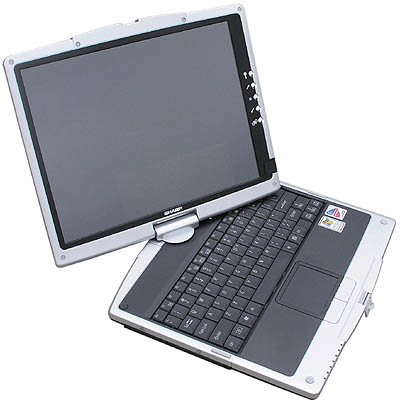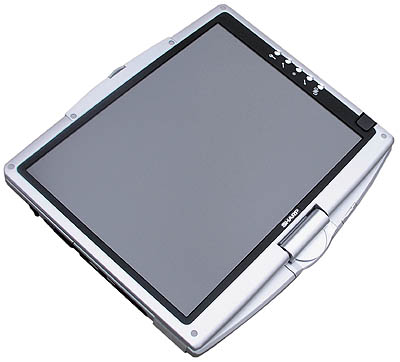

Current Cover
Recent issues






|
|
|
|
|
|
PenLab: Fujitsu Stylistic ST5000Sharp's first notebook convertible TPC features a superior display (May 2004 issue)Sharp Corporation was one of the many notebook makers that sat out the first round of Tablet PC hardware. The Osaka-based Japanese electronics giant, of course, often waits a generation or two before entering a new product category. The late entry of Sharp's Mobilon Windows CE-based handheld PCs was an example of that strategy. And when Sharp does join a market segment it does it's not always what one would expect, as exemplified by Sharp's Linux-based line of PDAs. This time, however, Sharp decided to play it straight and create a Tablet PC convertible based on tried and true technology, albeit with a few Sharp twists.
The Sharp Actius TN10W reviewed in this article began shipping in October of 2003, just about a year after the official introduction of the Tablet PC. It is an elegant, handsome "ultralight" notebook with a 11.4 x 10 inch footprint, a thickness of 1.13 inches, and a weight of about 4.2 pounds--figures comparable to those of the notebook convertibles from Toshiba and Fujitsu. The depth is actually more like 9.5 inches, but a large display hinge is built into a curved rear side and adds another half inch. The LCD case and the top part of the main body are clad in matte-silver magnesium with a very fine powder finish. Keyboard and LCD display as well as the bottom of the device are black. There's nary a piece of plastic in sight and everything feels solid. Designed for CentrinoOne advantage of the late start is that Sharp didn't have to switch from mobile Pentium III to Intel's Centrino technology just months after the Tablet PC was unveiled. Instead, the Actius was designed for Centrino: it has a 1.1 GHz M processor, the Intel 855GM chipset, and the Intel PRO Wireless Network Connection 802.11b. As a result, the Actius feels quick.In terms of connectivity, the Actius covers all the basics. On the right side you find two USB 2.0 ports, a standard video jack and a Kensington lock base. On the right are expansion slots: One Type II PC Card and one Compact Flash card. On the back are power, audio in and out, Firewire, and modem and network jacks. On the left back you can see a fairly large heat exchanger. All ports are uncovered except for the modem/network combo that sits behind a plastic door. The left front sports a battery of seven notification LEDs: power and battery status, wireless network, disk, and num/scroll/ caps lock. The Tablet PC-mandated hardware buttons are along the left side of the display: screen rotation, up/down, enter, and alt-ctl-del. The bottom right of the display case has what appears to be a space for an optional fingerprint reader. Turn the Actius upside down and you'll see no less than four screwed down covers plus the battery, a decent-sized 40 watt-hour Li-Ion affair. Sitting beneath the covers are a small Conexant Systems modem, a RAM expansion slot, the Intel PRO/Wireless 2100 Mini PCI adapter, and the 30GB Fujitsu hard disk amidst strips of shock mounting material.
Breakthrough displaySharp, of course, is a global leader in TFT technology and so it isn't a surprise that the TN10W comes with a special display. At first sight you think it is just a nice 12.1-inch 1024 x 768 pixel TFT. Larger than the 10.4-inch screens most first generation Tablet PCs had, and just about right for XGA resolution. However, this display also uses Sharp's Anti Glare Low Reflection (AGLR) technology. According to Sharp technical literature, AGLR uses a new light-diffusing low-reflection coating that refracts light at different rates to reduce screen glare from the approximately 5% of standard TFT LCDs to just 1.5%. Sharp claims that this makes the blacks more solid and displays letters and images "with greater vividness, even in a bright room." Side by side with a Toshiba Portege 3500, a white page on the Toshiba's display looked a bit yellowish compared to the Sharp's white-bluish tint. Blacks looked about the same to me, but faint grays were darker on the Sharp. The Sharp, however, offers totally superior viewing angle performance. The vertical viewing angle of the Toshiba is quite small. At severe angles the display looks like it reverses (as it does on all conventional TFTs) and becomes almost unviewable. The Sharp's vertical viewing angle range seems to be just about 180 degrees. No matter what angle you look at it, the screen remains bright and sharp and viewable and the picture is completely unchanged. As a result, colors and text seemed more vibrant and consistent as you view the display from different angles. The difference becomes even more dramatic in portrait mode. I've always felt that traditional LCDs, which were after all designed for landscape viewing in standard notebooks, were only marginally suitable for viewing in portrait orientation. It is one of the primary reasons why I rarely use a Tablet PC in portrait mode (the other reason is that almost all apps and web content is designed for landscape viewing). The Sharp's display totally eliminates that problem. This is a screen that performs as well in portrait as in landscape mode. Seems like a small issue, but makes all the difference in the world. I may be missing something as far as the Anti Glare coating goes. To my eye, the Toshiba had almost no glare at all whereas the Sharp had quite a bit. Overall, the Sharp screen offers a significant advantage.
Like all current notebook convertibles (Acer, Toshiba, Panasonic, Fujitsu, etc.), the Actius uses a center-mounted pivot that allows you to rotate the display 180 degrees so that the LCD points away from the keyboard, and then folds down to convert the device into a (relatively thick) slate. These screen pivots are certainly an elegant solution, but they have one drawback that drives me nuts: screen flex when you tap the display with the pen. On some designs this can be so bad that you need to hold the display with one hand to steady it before you can use the pen. The Sharp has a bit less flex, but still way too much. This is not Sharp's fault, but simply an inherent problem with this type of pivot. A loose and rather cheap-looking snap secures the LCD part against the main body of the Actius no matter which side of the display is up. The 92% KeyboardUnfortunately there is one other area that makes me wonder what Sharp's most excellent engineers were thinking when they designed it: the keyboard. It's a 82-key layout with light-gray lettering on dark-gray keys. Everything is nice and legible but the QWERTY layout isn't full size! Even though the Actius has a full-size footprint and there was plenty enough room for a standard, full-size keyboard, Sharp somehow decided to hobble this fine machine with a 92%-scale QWERTY section, making it feel cramped to touch-typists. Why Sharp would do that and use up the rest of the space with a backslash key that is a full inch wide is hard to comprehend.Overall, we see Sharp's first foray into Tablet PCs as a good product. The Actius TN 10W is attractive, well designed, and powerful enough to handle just about any task. It does have a few shortcomings, prime among them the smallish keyboard, but those are more than offset by its overall good design and a truly superior LCD display. At first sight it seems no different than any other 12.1-inch LCD, but it is, and dramatically so. I cannot emphasize enough how much better this screen is than any other Tablet PC display I have seen so far. Horizontal and vertical viewing angles--which are for all practical purposes a full 180 degrees--make this the first Tablet PC that you can truly use both in landscape and portrait orientation without losing screen readability. Sharp took a bit longer to get its first Tablet PC product to market, but with a screen this good, the wait was well worth it.
Sharp: www.sharpusa.com
-
|



